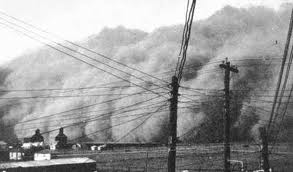Encyclopedia Dubuque
"Encyclopedia Dubuque is the online authority for all things Dubuque, written by the people who know the city best.”
Marshall Cohen—researcher and producer, CNN
Affiliated with the Local History Network of the State Historical Society of Iowa, and the Iowa Museum Association.
DUST STORM (1934)
DUST STORM (1934). The Dust Bowl was the name given to the drought-stricken southern plains region of the United States during a drought in the 1930s. High winds and choking dust swept from Texas to Nebraska, people and livestock were killed and crops failed across the entire region. The Dust Bowl intensified the crushing economic impacts of the Great Depression and drove many farming families on a desperate migration in search of work and better living conditions.
The Dust Bowl was caused by federal land policies, changes in regional weather, farm economics and other cultural factors. The Homestead Act of 1862 provided settlers with 160 acres of public land. This was followed by the Kinkaid Act of 1904 and the Enlarged Homestead Act of 1909 which led to a new and inexperienced farmers across the Great Plains.
Many of these late nineteenth and early twentieth century settlers believed the superstition that “rain follows the plow.” Emigrants, land speculators, politicians and even some scientists believed that homesteading and agriculture would permanently make the semi-arid Great Plains region better for farming. This false belief was linked to Manifest Destiny—an attitude that Americans had a sacred duty to expand west. A series of wet years during the period created further misunderstanding and the intensive cultivation of increasingly marginal lands that could not be reached by irrigation.
Rising wheat prices in the 1910s and 1920s and increased demand for wheat from Europe during WORLD WAR I encouraged farmers to plow up millions of acres of native grassland to plant wheat, corn and other row crops. But as the United States entered the GREAT DEPRESSION, wheat prices fell dramatically. Farmers tore up even more grassland in an attempt to harvest a bumper crop and break even.
Crops began to fail with the beginning of drought in 1931, exposing the bare, over-plowed farmland. Without deep-rooted prairie grasses to hold the soil in place, it began to blow away. Eroding soil led to massive dust storms and economic devastation—especially in the Southern Plains. The Dust Bowl, also known as “the Dirty Thirties,” started in 1930 and lasted for nearly a decade, but its long-term economic impacts on the region lingered much longer.
Massive dust storms began in 1931. During the Dust Bowl period, severe dust storms, often called “black blizzards,” swept the Great Plains. Some of these carried topsoil from Texas and Oklahoma as far east as Washington, D.C. and New York City, and coated ships in the Atlantic Ocean with dust. Billowing clouds of dust would darken the sky, sometimes for days at a time. In many places, the dust drifted like snow and residents had to clear it with shovels. Dust worked its way through the cracks of even well-sealed homes, leaving a coating on food, skin and furniture.
By 1934, an estimated 35 million acres of formerly cultivated land had been made useless for farming, while another 125 million acres—an area about three-quarters the size of Texas—was rapidly losing its topsoil. On May 11, 1934, a massive dust storm two miles high traveled 2,000 miles to the East Coast, blotting out monuments such as the Statue of Liberty and the U.S. Capitol. On May 9, 1934, brownish earth from Montana and Wyoming swirling up from the ground was caught by high-level winds and was blown eastward. More dirt was picked up along the way until an estimated 350 million tons was roaring toward the urban settlements in the east. (1) The storm reached Dubuque and Madison by late in the afternoon and by evening was dumping 12 million tons on Chicago--four inches for each resident. On May 14th ships 300 miles off the coast of the United States reported dust on their decks. (2)
The worst dust storm occurred on April 14, 1935. News reports called the event Black Sunday. A wall of blowing sand and dust started in the Oklahoma Panhandle and spread east. As many as three million tons of topsoil are estimated to have blown off the Great Plains
A series of drought years followed worsening the environmental disaster. Although regular rainfall returned to the region by the end of 1939, economic effects, continued. Population declines in the worst-hit counties—where the agricultural value of the land failed to recover—continued well into the 1950s. (3)
---
Source:
1. "Dust Bowl," History Channel, Online: https://www.history.com/topics/great-depression/dust-bowl
2. Huggett, Richard John. Fundamentals of Geomorphology - Page 337 https://www.google.com/search?q=dust+storm+in+dubuque+%281935%29&ie=utf-8&oe=utf-8&aq=t&rls=org.mozilla:en-US:official&client=firefox-a#q=dust+storm+in+dubuque+%281935%29&hl=en&client=firefox-a&hs=El4&tbo=d&rls=org.mozilla:en-US:official&ei=l6WtUIyuC4SQ9gSB1oDYCg&start=10&sa=N&bav=on.2,or.r_gc.r_pw.r_qf.&fp=10ba8070072772da&bpcl=38897761&biw=901&bih=401
3. History Channel


